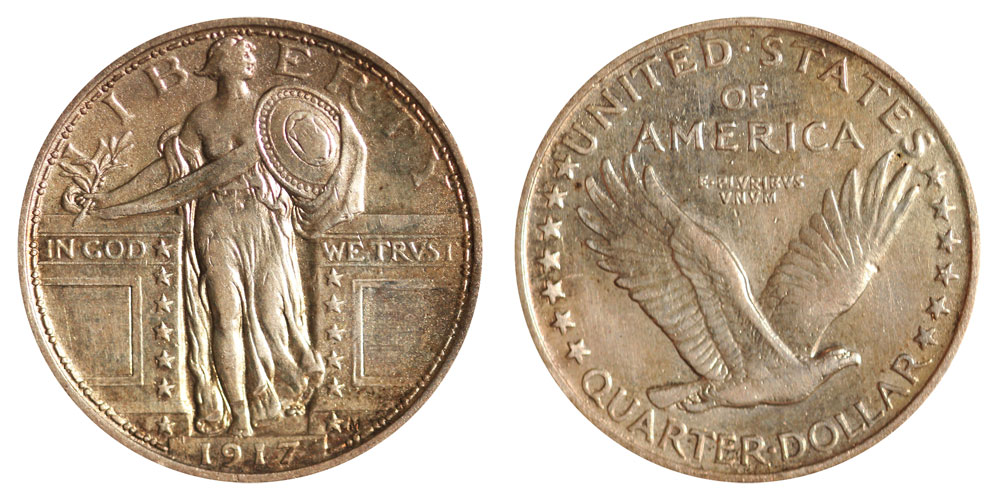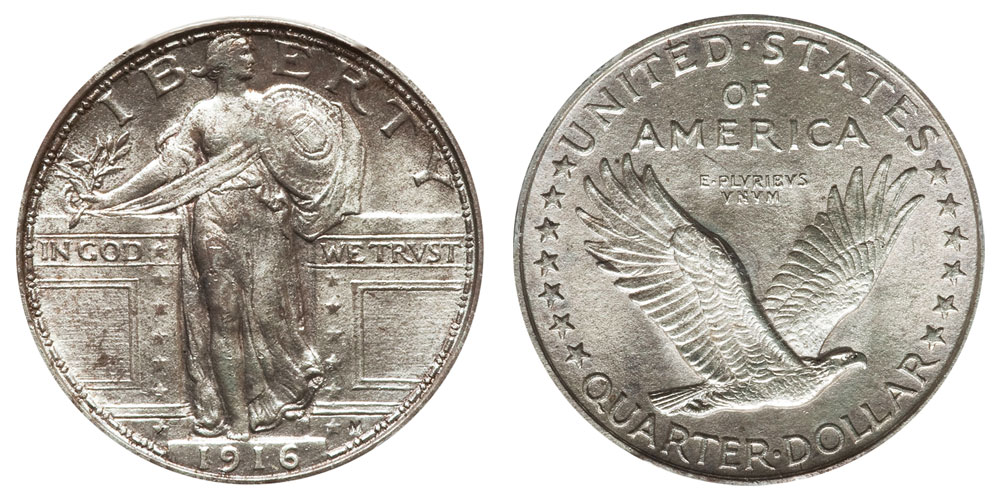Standing Liberty Quarters Worth Money
Virtually all Standing Liberty quarters are worth more than their melt value (roughly $5). Many of them are worth hundreds of dollars, in fact.
Follow the link to view a complete price chart of all Standing Liberty quarters.
The Standing Liberty quarter does not get the publicity that the Mercury dime or Walking Liberty half dollar does, but it still has its own fans. Let’s take a look at the myths and history surrounding this famous coin, and find out which Standing Liberty quarters are worth money.

Standing Liberty quarter (Type I)
The Origin of the Standing Liberty Quarter
Theodore Roosevelt kicked off America’s “Renaissance” of its coinage in 1907 when new designs for the $10 eagle and $20 double eagle gold coins by Augustus Saint-Gaudens entered circulation. By 1913, all four circulating gold coins, the cent, and the nickel had new, artistic designs.
The dime, quarter, and half dollar became eligible for replacement in 1916 and the Mint wasted no time in replacing the last of the old “Barber” designs on the nation’s coins. A competition was held in 1915 where artists were invited to submit designs for all three coins. Hermon MacNeil’s “Standing Liberty” won the contest for the quarter. The design was more aligned with the older Seated Liberty quarter motif, showing Lady Liberty's full body rather than a simple face profile.
Delays in finalizing the design (mainly due to objections by Mint Chief Engraver Charles Barber, whose coin designs were being replaced) meant that only 52,000 Standing Liberty quarters were struck at the end of 1916.
Hiding the Booby
A widespread myth about Liberty’s exposed breast in the original Standing Liberty design and covering thereof asserts that moral outrage was responsible for the design change midway through 1917. This “fact” has been repeated for decades and has even worked its way into numismatic reference guides. However, research into the matter shows that there was little, if any, public scandal over the design.
Noted numismatic historian Roger Burdette researched “the legend of the booby,” and found no contemporary evidence of moral outrage over the design. On the contrary, articles in major newspapers at the time noted the distinct lack of controversy over Liberty’s attire.
Because MacNeil made other changes to the design, such as redesigning Liberty’s head and rearranging the stars on the reverse, the current theory is that clothing Liberty in chainmail was a reaction to America’s entry into World War I. An exposed bosom on Liberty could be seen as weakness or vulnerability to America’s enemies, now that we were at war.
Revising the Date
The Standing Liberty quarter shared one design flaw with the Buffalo nickel: the dates on both coins sat relatively high above the field, and quickly wore away in circulation. While the problem was for the most part ignored on the nickel, the date at Liberty’s feet on the quarter was recessed in 1925.
A Good Head on Her Shoulders
Much like Jefferson nickel collectors use “Full Steps” on Monticello as a mark of excellence, Standing Liberty quarter collectors use “Full Head” standards to identify superior strikes.
Liberty’s head is one of the highest places on the Standing Liberty quarter. This means that not only is it one of the first places to show wear, but that a less than full strike does not bring out the full details in the first place.
Major coin grading services use the following criteria when awarding a Full Head (FH) designation:
- All three leaves on Liberty’s helmet are complete and distinct;
- The bottom of the helmet across Liberty’s forehead must be complete;
- The ear hole in the helmet must be distinct.
It is very rare for a Standing Liberty quarter to meet these criteria, which explains the large premium these coins command. For example, a 1918 Standing Liberty quarter in MS65 is priced at $550. The same coin is worth $2,500 if it is a Full Head example.
.png)
Standing Liberty Quarter with Full Head details (John Baumgart, Wikipedia)
Standing Liberty Quarters Worth The Most Money
These are the top five most expensive Standing Liberty quarters. It is no surprise that these are all Key Date mintages.
Price Chart: The Standing Liberty Quarters Worth The Most Money
| 1918/7-S | $100,000 |
| 1916 | $30,000 |
| 1927-S | $15,000 |
| 1919-S | $10,000 |
| 1919-D | $5,000 |
Prices for MS65 grade
Key Date Standing Liberty Quarters
The Standing Liberty quarter had a relatively short run, as it was replaced by the Washington quarter in 1932 in celebration of the 200th anniversary of the Founding Father’s birth. There are, however, five key dates in the series.
1916
The 1916 Standing Liberty quarter checks nearly every box for being a key date coin. It’s a first year of issue, it’s a one-year issue, and has an incredibly low 52,000 mintage. With the worst possible grade still fetching $1,000, this will be the big purchase for anyone assembling a complete set of Standing Liberty quarters.

1916 Standing Liberty quarter
1918/7 S
The 1918/7 overdate from the San Francisco Mint is the only big variety in the Standing Liberty series. A blatantly obvious overdate and miniscule population makes this coin not only a top key date, but the most expensive Standing Liberty rarity in high Mint State grades.
.jpg)
Standing Liberty 1918/7 S Overdate (PCGS)
1919-D
The 1919-D Standing Liberty quarter had a mintage of less than 2 million coins, and relatively few of those have survived to the present day. This date remains expensive across the board.
1919-S
The 1919-S Standing Liberty quarter also had a sub-2-million-coin mintage, with a similar number of survivors and similar prices as the 1919-D. The 1919-S has few survivors in the highest uncirculated grades compared to the 1919-D. This is reflected in substantially higher prices for the 1919-S when compared to the Denver mintage.
1927-S
At just 396,000 coins, the 1927-S Standing Liberty quarter has the lowest mintage by far of the series but for the 52,000 mintage of the 1916 quarter This has made the 1927-S a conditional rarity and one of the most expensive Standing Liberty quarters in higher circulated and in uncirculated grades.
Standing Liberty Quarter Values: Complete Chart
| 1916 | 52,000 | $8,000 | $10,000 | $13,000 | $30,000 |
| 1917 TYPE 1 | 8,740,000 | $25 | $175 | $250 | $900 |
| 1917-D TYPE 1 | 1,509,200 | $175 | $225 | $300 | $1,000 |
| 1917-S TYPE 1 | 1,952,000 | $175 | $275 | $350 | $1,250 |
| 1917 TYPE 2 | 13,880,000 | $100 | $140 | $200 | $700 |
| 1917-D TYPE 2 | 6,224,400 | $170 | $210 | $280 | $1,500 |
| 1917-S TYPE 2 | 5,552,000 | $160 | $200 | $275 | $1,250 |
| 1918 | 14,240,000 | $70 | $95 | $150 | $550 |
| 1918-D | 7,380,000 | $115 | $180 | $275 | $2,000 |
| 1918-S | 11,072,000 | $70 | $125 | $275 | $1,750 |
| 1918/7-S | ** | $4,500 | $7,750 | $12,500 | $100,000 |
| 1919 | 11,324,000 | $95 | $130 | $200 | $650 |
| 1919-D | 1,944,000 | $550 | $900 | $1,400 | $5,000 |
| 1919-S | 1,836,000 | $500 | $800 | $1,250 | $10,000 |
| 1920 | 27,860,000 | $60 | $80 | $150 | $650 |
| 1920-D | 3,586,400 | $225 | $325 | $400 | $2,500 |
| 1920-S | 6,380,000 | $60 | $150 | $300 | $3,000 |
| 1921 | 1,916,000 | $600 | $900 | $1,250 | $3,000 |
| 1923 | 9,716,000 | $50 | $80 | $150 | $650 |
| 1923-S | 1,360,000 | $1,000 | $1,750 | $2,250 | $4,500 |
| 1924 | 10,920,000 | $50 | $80 | $150 | $650 |
| 1924-D | 3,112,000 | $165 | $240 | $310 | $650 |
| 1925* | 12,280,000 | $30 | $70 | $110 | $450 |
| 1926 | 11,316,000 | $30 | $70 | $105 | $500 |
| 1926-D | 1,716,000 | $57 | $110 | $140 | $550 |
| 1926-S | 2,700,000 | $65 | $200 | $500 | $3,000 |
| 1927 | 11,912,000 | $30 | $75 | $125 | $500 |
| 1927-D | 976,000 | $110 | $200 | $275 | $650 |
| 1927-S | 396,000 | $325 | $1,500 | $4,250 | $15,000 |
| 1928 | 6,336,000 | $30 | $70 | $100 | $450 |
| 1928-D | 1,627,600 | $30 | $70 | $100 | $450 |
| 1928-S | 2,644,000 | $30 | $70 | $100 | $450 |
| 1929 | 11,140,000 | $30 | $70 | $100 | $450 |
| 1929-D | 1,358,000 | $30 | $70 | $100 | $450 |
| 1929-S | 1,764,000 | $30 | $70 | $100 | $450 |
| 1930 | 5,632,000 | $30 | $70 | $100 | $450 |
| 1930-S | 1,556,000 | $30 | $70 | $100 | $450 |
No Standing Liberty quarters were struck in 1922 or 1931
* First mintage with recessed date
** Included in above mintage
Read more about coin values from the expert authors at Gainesville Coins:
2009 Lincoln Penny Value: Bicentennial Cents
1965 Quarter Value: Error Coins and History
1944 Lincoln Wheat Penny Value Guide
What's the Value of a 1970 Quarter?
Canadian Quarters Worth Money: From 1870 to Today

Steven Cochran
A published writer, Steven's coverage of precious metals goes beyond the daily news to explain how ancillary factors affect the market.
Steven specializes in market analysis with an emphasis on stocks, corporate bonds, and government debt.
